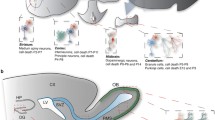Abstract
During brain development, cell death is a physiological process which allows the elimination of cells produced in excess. During adulthood, when there is no or little physiologic cell death, an increase in cell loss is usually caused by neurologic disorders or by exposure to neurotoxic chemicals. Measurements of cell death are often used a first line of investigation on chemicals. Cell death in neuronal or glial cultures in vitro can be quantified with a variety of assays based on different properties of live and dead cells. Thus, healthy cells exclude dye (e.g., trypan blue, propidium iodide) or possess metabolic activity to cause a compound’s conversion to a colored or fluorescent one (e.g., MTT, calcein AM) while dead cells do not. Conversely, dying cells release enzymes in the medium (e.g., LDH) whose quantification is proportional to the number of dead cells. This chapter describes several relatively rapid, inexpensive and reliable methods for measuring cell death and in neurons and astrocytes in primary cultures or in neuronal and glial cell lines.
Access this chapter
Tax calculation will be finalised at checkout
Purchases are for personal use only
Similar content being viewed by others
References
Honig L.S., Rosenberg R.N. (2000). Apoptosis and neurologic disease. Am J Med. 108, 317–30.
Kerr J.F. (1972) Shrinkage necrosis of adrenal cortical cells. J Pathol. 107, 217–9.
Kerr J.F. (1971) Shrinkage necrosis: a distinct mode of cellular death. J Pathol. 105, 13–20.
Troost D., Aten J., Morsink F., de Jong J.M. (1995). Apoptosis in amyotrophic lateral sclerosis is not restricted to motor neurons. Bcl-2 expression is increased in unaffected post-central gyrus. Neuropathol Appl Neurobiol. 21, 498–504.
Dragunow M., Faull R.L., Lawlor P., et al. (1995). In situ evidence for DNA fragmentation in Huntington’s disease striatum and Alzheimer’s disease temporal lobes. Neuroreport. 6, 1053–1057.
Uliasz T.F., Hewett S.J. (2000) A microtiter trypan blue absorbance assay for the quantitative determination of excitotoxic neuronal injury in cell culture. J Neurosci Methods. 100, 157–63.
Trost L.C., Lemasters J.J. (1994) A cytotoxicity assay for tumor necrosis factor employing a multiwell fluorescence scanner. Anal Biochem. 220, 149–53.
Koh J.Y., Choi D.W. (1987) Quantitative determination of glutamate mediated cortical neuronal injury in cell culture by lactate dehydrogenase efflux assay. J Neurosci Methods. 20, 83–90.
Haslam G., Wyatt D., Kitos P.A. (2000). Estimating the number of viable animal cells in multi-well cultures based on their lactate dehydrogenase activities. Cytotechnology. 32, 63–75.
Wolterbeek H.T., van der Meer A.J. (2005). Optimization, application, and interpretation of lactate dehydrogenase measurements in microwell determination of cell number and toxicity. Assay Drug Dev Technol. 6, 675–82.
Nicotera P., Ankarcrona M., Bonfoco E., Orrenius S., Lipton S.A. (1997). Neuronal necrosis and apoptosis: two distinct events induced by exposure to glutamate or oxidative stress. Adv. Neurol. 72, 95–101. Review.
Mosmann T. (1983) Rapid colorimetric assay for cellular growth and survival: application to proliferation and cytotoxicity assays. J Immunol Methods. 65, 55–63.
Author information
Authors and Affiliations
Corresponding author
Editor information
Editors and Affiliations
Rights and permissions
Copyright information
© 2011 Springer Science+Business Media, LLC
About this protocol
Cite this protocol
Giordano, G., Hong, S., Faustman, E.M., Costa, L.G. (2011). Measurements of Cell Death in Neuronal and Glial Cells. In: Costa, L., Giordano, G., Guizzetti, M. (eds) In Vitro Neurotoxicology. Methods in Molecular Biology, vol 758. Humana Press, Totowa, NJ. https://doi.org/10.1007/978-1-61779-170-3_11
Download citation
DOI: https://doi.org/10.1007/978-1-61779-170-3_11
Published:
Publisher Name: Humana Press, Totowa, NJ
Print ISBN: 978-1-61779-169-7
Online ISBN: 978-1-61779-170-3
eBook Packages: Springer Protocols




